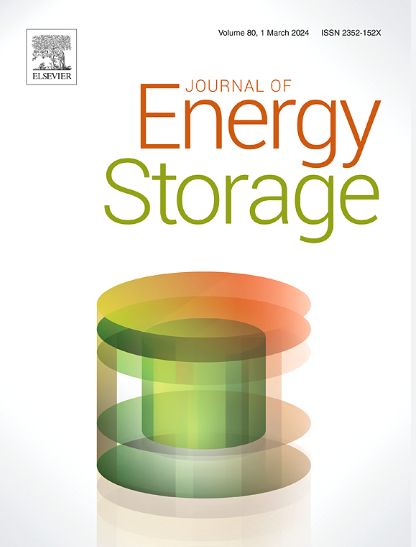Multiscale collaborative optimization guided synthesis of ZIF&MOG-derived bifunctional electrocatalysts fabricated via in-situ self-assembly in carbon nanofibers for durable zinc-air batteries
IF 8.9
2区 工程技术
Q1 ENERGY & FUELS
引用次数: 0
Abstract
As key materials in high-efficiency clean energy technologies, zeolitic imidazolate framework (ZIF) and metal-organic gel (MOG) materials have shown great potential. However, they suffer from issues such as insufficient electrical conductivity, stability, and active sites. To enhance the comprehensive performance of electrocatalytic materials, In this study, electrospinning technology was adopted to in-situ embed the ZIF-MOG precursor during the formation process of nanofibers. A graphene conductive fiber network was constructed through the high temperature carbon ring closure of organic fibers, resulting in the fabrication of the efficient catalyst of ZIF-MOG derived carbon nanofibers (ZM-CNF) with dual functions of oxygen reduction reaction (ORR) and oxygen evolution reaction (OER). Raman spectroscopy and BET tests indicate that the ZM-CNF material has a high specific surface area, an appropriate degree of graphitization, and a mesoporous distribution. Electrochemical analysis indicated that the ORR half-wave potential for this catalyst is as high as 0.80 V, and the overpotential for OER is 396 mV at a current density of 10 mA cm−2. By means of a balanced design of defect engineering and conductive networks, ZM-CNF achieved a synergistic optimization of catalytic performance and charge transfer efficiency. In the application test of zinc-air batteries, the battery assembled with ZM-CNF achieved a maximum power density of 115.7 mW cm−2 and an open-circuit voltage of 1.442 V, which is comparable to the performance of the battery assembled with the commercial Pt-RuO2 catalyst. During the 180 h charge-discharge cycle test, the charge-discharge efficiency of the ZM-CNF battery did not exhibit significant attenuation, demonstrating excellent electrocatalytic performance and cyclic stability. This study broadens the perspective for the structural regulation design of high-performance composite catalysts for energy storage and conversion applications.
基于多尺度协同优化的zif&mog衍生双功能电催化剂的合成研究
沸石咪唑盐框架(ZIF)和金属有机凝胶(MOG)材料作为高效清洁能源技术的关键材料,显示出巨大的发展潜力。然而,它们存在导电性、稳定性和活性位点不足等问题。为了提高电催化材料的综合性能,本研究采用静电纺丝技术在纳米纤维形成过程中原位嵌入ZIF-MOG前驱体。通过有机纤维的高温碳环闭合构建石墨烯导电纤维网络,制备了具有氧还原反应(ORR)和析氧反应(OER)双重功能的ZIF-MOG衍生碳纳米纤维(ZM-CNF)高效催化剂。拉曼光谱和BET测试表明,ZM-CNF材料具有较高的比表面积、适当的石墨化程度和介孔分布。电化学分析表明,在电流密度为10 mA cm−2时,该催化剂的ORR半波电位高达0.80 V, OER过电位为396 mV。通过缺陷工程和导电网络的平衡设计,ZM-CNF实现了催化性能和电荷转移效率的协同优化。在锌空气电池的应用测试中,ZM-CNF组装电池的最大功率密度为115.7 mW cm−2,开路电压为1.442 V,与商用Pt-RuO2催化剂组装电池的性能相当。在180 h充放电循环试验中,ZM-CNF电池的充放电效率没有出现明显衰减,表现出优异的电催化性能和循环稳定性。本研究为储能转化用高性能复合催化剂的结构调控设计拓宽了思路。
本文章由计算机程序翻译,如有差异,请以英文原文为准。
求助全文
约1分钟内获得全文
求助全文
来源期刊

Journal of energy storage
Energy-Renewable Energy, Sustainability and the Environment
CiteScore
11.80
自引率
24.50%
发文量
2262
审稿时长
69 days
期刊介绍:
Journal of energy storage focusses on all aspects of energy storage, in particular systems integration, electric grid integration, modelling and analysis, novel energy storage technologies, sizing and management strategies, business models for operation of storage systems and energy storage developments worldwide.
 求助内容:
求助内容: 应助结果提醒方式:
应助结果提醒方式:


